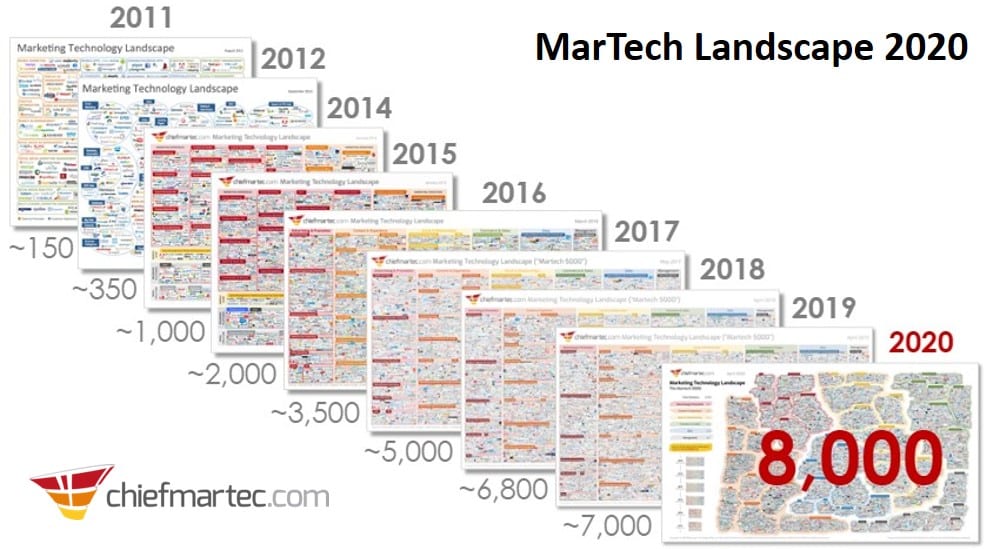
Scott Brinker on MarTech: Executive Insights
I first had the opportunity to first hear Scott Brinker, VP of Platform Ecosystem at HubSpot, speak at the ITSMA Marketing Vision event several years ago. I later saw him give the keynote address at the Boston MarTech Conference along with guest appearance on marketing-related webinars.
Scott has published the chiefmartec.com blog since 2008 and speaks at many industry events including the MarTech conference (which Scott leads as program chair) a major industry event with both East and West Coast venues.
This year COVID19 threw a monkey wrench at the spring event – instead of being in-person in San Jose, it was a virtual event. My long-time webinar partner ON24 hosted the event and it was flawlessly executed over the course of three days with multiple keynotes from Scott.
Adding to the fun, Scott threw in the twist of “MarTech like a pirate” in his opening-day keynote and was immediately christened the “MarTech Pirate” on social media (check out #MarTechpirate).
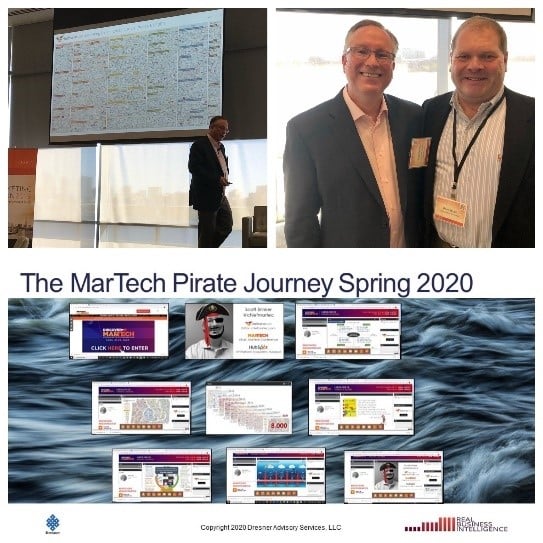
Everything consistently highlighted Scott’s tremendous expertise in the field of Marketing, Operations and Technology (MarTech) which helped earned him the title the “Father of MarTech.”
The Marketing Technology Landscape Scott and his team publish annually has tracked the rapid growth of MarTech. I have enjoyed sharing this for years to audiences in my own speaking engagements, and the insights in segmentation, trends and growth are always very well received.
The audience at this spring’s event was rewarded with an update of the “MarTech 5000” which was over 7,000 applications last year and grew to over 8,000 when netting out both growth and “churn” from last year.
While attending the 2019 ITSMA Marketing Vision event at the MIT Samberg Conference Center and the spring MarTech virtual event, I was again thrilled to see Scott speak.
His insights and presentation were absolutely a highlight of both events. It was my pleasure to recently to sit down virtually with Scott and discuss the “brave new world” of MarTech, “Modern marketing” and much more.
Q: We highlighted your analysis of the MarTech Landscape on our recent Dresner Advisory Services “Tweetchat” and there was, as expected, lots of interest in the latest Marketing Technology Landscape. We are now up to over 8,000 different Marketing Technology (MarTech) applications, up from the year before (7,000+). What happened to the long-expected consolidation, what do you think the second half 2020/2021 results will show, and will we finally see consolidation in MarTech solutions?
A: Well obviously the caveat to anything is that the business impact of COVID19 has certainly in the short-term thrown lots of uncertainty into pretty much every industry; hence any predictions we make about the next 12-18 months need some humility and the proverbial grain of salt.
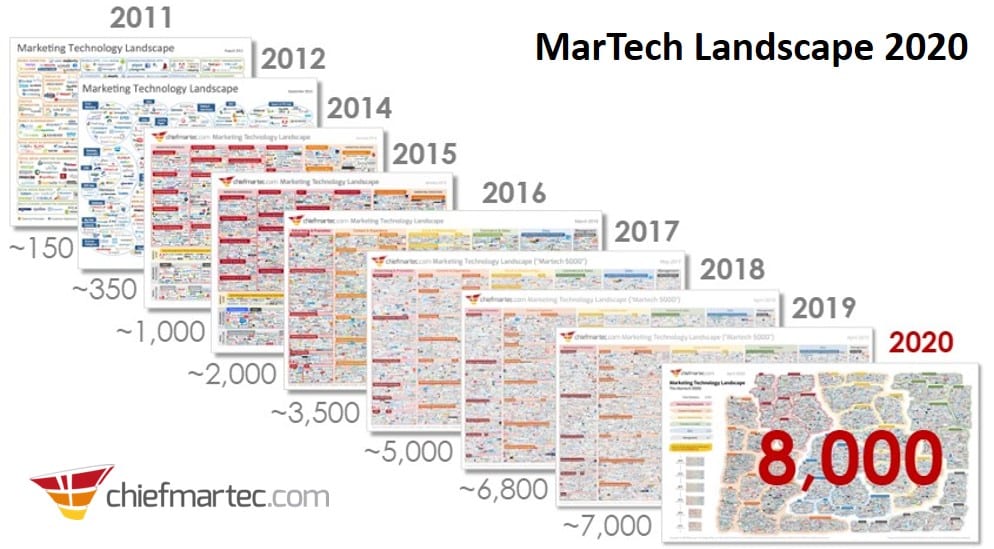
What we are seeing in the MarTech industry is consolidation on one hand, there are the major marketing platforms, marketing clouds, and a relatively small group of companies that dominate the MarTech industry.
But what is fascinating is even as you see this incredible consolidation with leaders within specific categories, there is in parallel a continuous arrival of innovative MarTech start-ups.
Many are entering the market because of the consolidation with these major marketing platforms. They provide a validated, stable platform upon which more specialist applications address specialized needs. The analogy I often use is the Apple/Android consolidation that fundamentally defined platform ownership, spawning large amounts of creative and innovative new applications.
So, I think we will see more consolidation through 2021 from the larger companies, but I suspect we will see as many applications as we have today that are these specialized MarTech solutions revolving in orbit around these “centers of gravity” and ecosystems.
Q: When you spoke at the ITSMA Marketing Vision conference last fall you showcased a set of “new rules for marketing and operations” and an outstanding model with a two axis/quadrant model of centralization/decentralization and humanization/automation with change smack in the middle and driving entirely new pressures on marketing. How has this been received, and any updates to report between last fall and this spring’s MarTech conference?
A: The model is based upon two fundamental axes, and the idea of balancing centralization and decentralization on one and automation and human innovation on the other. The world has certainly become more attuned to both dimensions and that is what customer experience (CX) and modern marketing are all about.
Looking at centralization, we know it is important as ever to have centralized orchestration, the single source of the truth, for customer, product, and campaign data. This is the place where everyone can navigate and operate by what I call a “common set of celestial objects”.
But at the same time, while you want that strong centralized foundation and a universal source of the truth, you need to be empowering people to create specialized campaigns for a highly targeted set of customers, supported by workflow to optimize their impact, and creating digital touchpoints to interest with customers and support the CX journey.
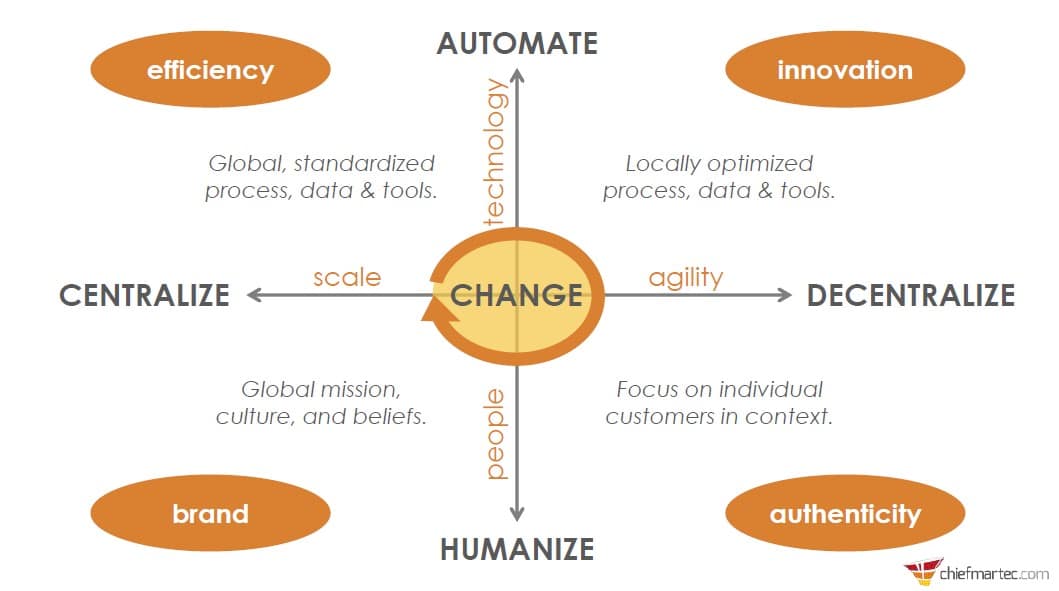
We have so many things to consider as the world is becoming more digital – and in today’s environment, many activities are almost entirely digital! It is almost impossible to have all that creation happen through one centralized team.
It is analogous to the “IT applications backlog” of a generation ago – instead of you having to wait on just IT, you wait on marketing operations, log a ticket and wait in a queue given bandwidth and resource constraints that creates time delays.
That holds back organizations and marketers, but if the centralized function can increasingly give people throughout the organization more “self-service” capability (supported by good governance and “guard rails”) they can dramatically accelerate the amount of digital creation and the speed at which it happens.
I think the world is embracing decentralized, empowered creation within marketing and with it, humanization supported by automation to allow everyone to work at scale and in an efficient manner.
We have been reminded many times during this current crisis of “what wins” – the heart and minds of our customers is not about behaving as an efficient machine but as humans and with empathy, that can adapt to these exceptions, because not everything is “one size fits all”.
Automation gets us the required efficiency, something we appreciate more than ever, but we must empower marketers, salespeople and customer serviced and empower the rest of the organization to make “human decisions” on top of our automation. I believe that is a key to building a great company of the 2020s and beyond.
Q: You have done a lot of work around the concept of the “Marketing Technologist” and the degree to which this is a required competency of every “modern marketer”. What are the major personas you see today, the required skills, technologies and applications are there significant gaps marketers must address?
A: The idea of the Marketing Technologist really started about 10 years ago, and recognized that there was an emerging hybrid marketing professional, working in the marketing department, with an allegiance to the marketing mission, but with a certain set of technical skills.
Sometimes these skills came from a previous career in software and/or IT and sometimes, they just decided to learn it having been intrigued by how technology and tools could make new things possible. And so, they brought that to their work in the marketing department. What is interesting is how over the past decade the number of activities in marketing that leverage that hybrid talent has absolutely exploded.
In fact, it is increasingly hard to find roles in marketing that do not have this requirement to a certain degree!
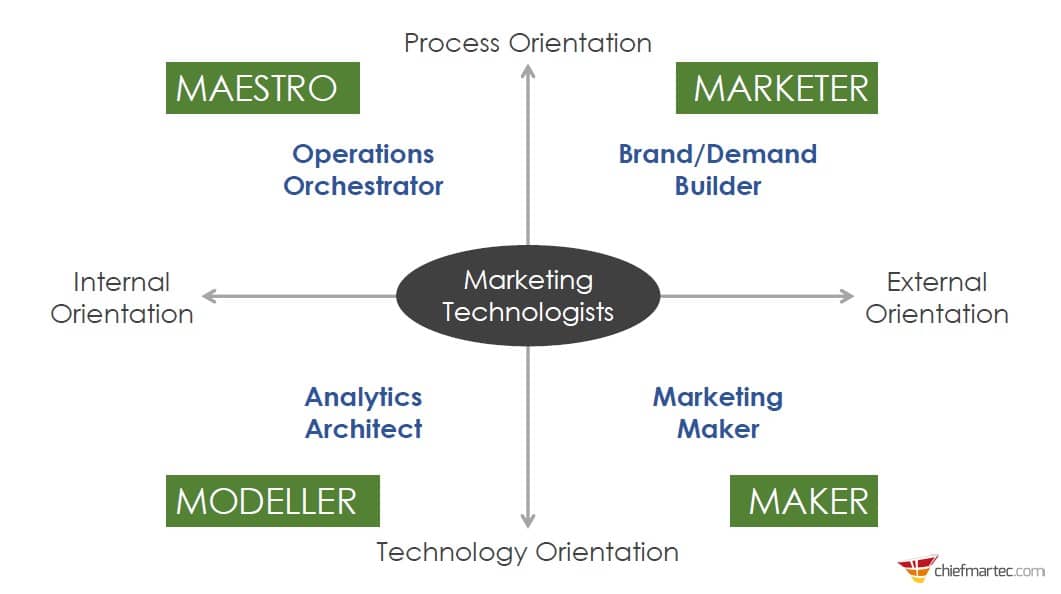
And as I showcased earlier, I love a good “two by two matrix” and recently put together a model to describe the “flavors” of the marketing technologist in the marketing department.
We are starting to see some specialization within the profession – on the first axis, is the role primarily externally facing, i.e. serving prospects, customers, and partners, or is it more internally facing with stakeholders within the organization?
And the second axis is a focus on the process, how things flow from an external perspective.
For example, we may think of the Customer Journey and CX from an internal perspective, for example workflow and process management, but what about the technology?
This is where you see the people who are building web sites and applications and creating new offerings, I think of them as “market makers”, and they are actually creating these new technology offerings for an external audience then building them internally. And we have a set of people that the “data architects” and “data scientists” within marketing departments, who bring a hybrid set of skills including data and analytics. The largest set of people are those who are both “process-oriented” and focused primarily on the external audience.
And there are the tech savvy marketers, they are running campaigns and [primary brand and demand generation builders. They are using things like Marketing Automation Platforms (MAP), CRM and MarTech and leverage these tools every day.
They are focused upon the business outcomes and how it impacts the customer journey and CX. On the other side, these folks are more process-oriented, serving internal constituencies and marketing stakeholders; they are the “maestros”, operations orchestrators of the MarTech Stack, and spend most of their time working with these tools. And of course, in workflow management, spreadsheets and other tools comprising their organization’s own unique MarTech stack.
That is the full spectrum of people who are “marketing technologists” — they have a specialization, as tech-savvy marketers, as a marketing operations leader, an analytics architect or as an actual developer and market maker.
Q: What are the key aspects of “Data-Informed Decision Making”, how does Business Intelligence (BI), data and analytics play, and how do we best prepare for and support this as we continue to transform marketing?
A: That is a great question! I definitely like the phrase “data-informed” because I sometimes feel like “data-driven” means there is so much data that we can access, that in some way the “data tail wags the decision dog”.
And that the decision fits the possible answer because somewhere you can find the data to support the desired action. You are biased, you search for what will support the decision and find data to support what you already concluded and say, “I see the data and it fits”!
Unfortunately, that does not make the business more effective. Being “data informed” is much more of framing questions, creating hypotheses, and even run experiments with a limit; this is a great scenario for our personas model and specifically the data architect. We are driven by business questions and hypotheses and it does not require “NASA quality clean rooms” of data – data “good enough” for making reasonable decisions.
And with the ability to define experiments within these hypotheses, this supports the concepts of decentralization we discussed earlier, as well as empowering people throughout the organization to test hypotheses, run experiences and collaborate and share the results.
And the broader this experimentation capability can be distributed throughout the organization the more you become a true “learning organization” – a key capability of the “future of work” and other mainstream transformations that support modern marketing.
Q: You mentioned a “second golden age of MarTech” this spring, which was new since last fall; what is it and what can we look forward to? And given ubiquitous change, what is your advice to Marketers to address “MarTech’s Law” where Marketing Technology changes more rapidly than organizations themselves?
A: The past ten years was the first golden age of MarTech, which was this incredible explosion of marketing technology as we went from a couple hundred MarTech tools to the thousands. And with it, from a few marketing technologists in our marketing department to literally everyone having these tools and a marketing technology bent of some kind in their work.
What is going to happen in this second golden age of MarTech in the decade ahead is the resolution of several dichotomies we have struggled with in the last decade.
The first is suite versus best of breed, and do I buy all my MarTech tools from one vendor, because they supposedly all work together. Or do I choose them across the MarTech landscape and connect them all together?
I believe we are moving from a different view of suite versus best of breed in the second golden era of MarTech – to platform ecosystems as discussed earlier, major platforms providing maybe 80 percent of core functionality and augment with specialist applications that are designed to integrate with these platforms.
The second is one that we all have struggled with, there were once distinct services and software companies. No more – a new reality of the second golden age of MarTech is software companies offering more services and services companies offering more software. We are coming to a world where these two are blended.
The third is we used to frame the decision of “build versus buy” for commercial software. In some ways this is the domain of the platform ecosystems – we are seeing the same thing for custom software inside an organization, instead of build versus buy it is a decision to start with a commercial platform and then augment with specialized applications and processes designed for your specific business.
And regarding “MarTech’s Law” the idea is that technology is changing faster than any organization can absorb it. There is no silver bullet here I can offer, but there are two things we can recommend from this.
One – be very strategic and deliberate with the changes we will embrace; we simply cannot embrace them all and must focus upon what is most important to our business and our customers.
Secondly – we cannot change as fast as the technology curve itself is changing. If we become more agile (embracing techniques from software development that are now becoming mainstream in modern marketing) we become more agile and can change faster than out competitors. And that becomes a truly sustainable competitive advantage.
Thanks, Scott for your tremendous insights!
Scott Brinker is Vice President of Platform Ecosystem at HubSpot, Editor at chiefmartec.com, Program Chair of the MarTech conference series and a frequent speaker at conferences on marketing technology and agile marketing. Be sure to follow Scott on chiefmartec.com and attend one of the outstanding MarTech Conference events. Check out my blog on the 2019 ITSMA Marketing Visions conference and how SAP has used Account-Based Marketing (one of many great MarTech tools) to leverage ABM in an award-winning approach with impressive results and some thoughts I recently shared on the outstanding spring 2020 MarTech Conference.
Fred Isbell is a high technology industry marketing veteran, former Senior Marketing Director for SAP Global Marketing and a Research Director at Dresner Advisory Services.
Join Fred online: Twitter, Facebook, LinkedIn



